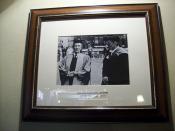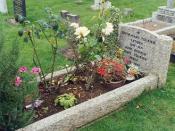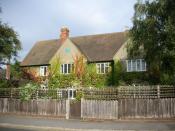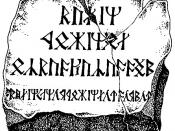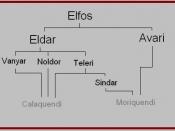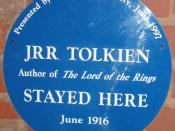SSL the Lord Of The Rings J.R.R. Tolkien was a fascinating man with contrasting ideals his major great work the Lord of the rings trilogy "The Fellowship of The Ring", "The Two Towers" and, "The Return of The King". This essay will be looking at the influences on these books from noirs myths to his faith. Tolkien was born on January 3, 1892, in Bloefontain, South Africa while on holiday in England his father died and his mother and Tolkien never returned to South Africa. When Tolkien was twelve, his mother died, leaving him in the care of Roman Catholic priest called Father Francis Morgan, with whom he lived for many years.
J.R.R. Tolkien was a man of many careers. His first occupation was a second lieutenant in World War 1, which he despised. War, he said, was "animal horror". After the war ended, he worked as a lexicographer researching the meaning and origins of words beginning with 'W' for the Oxford English Dictionary.
Following this, he became a lecturer and researcher in Anglo-Saxon and Middle English at the University of Leeds, where he worked for the next five years. In 1925, a position at Oxford for a professor of Anglo-Saxon became vacant, and Tolkien was appointed at only thirty-two years of age.
Myths and legends were always fascinating to Tolkien, and he believed no fairy-story was suitable to read if it could not be enjoyed by adults. He also wanted to give England, his country, and its own set of myths and legends similar to the Finnish Kalevala or the Norse legend Midgard. Tolkien borrows from Norse mythology. The god Aule is essentially Thorian in character: the god of the forge and the wielder of the hammer. It is he who creates the Dwarves, as one would expect since Dwarves are central to Norse mythology. Tolkien draws the very names of the Dwarves, and other characters, straight from Norse legends: Durin, Thrain, Thror, Fili, Kili, Bifur, Bofur, Dain -- and even Gandalf. Also it is worth noting that the men of Gondor wear large wings on there helms such as the popular view of the Vikings also it also says that there orings are from across the sea as the Viking would have been to the people of the United Kingdom. Tolkien also uses runes as the form of writing most commonly used in the books runes were the language of the Norse peoples made to be carved on wood and bone.
Naturally, though, Tolkien is most heavily influenced by Anglo-Saxon mythology. The codes of behavior, modes of dress and of battle and style of architecture are highly Arthurian, featuring hordes of knights in shining armor, fire-breathing dragons in the tradition of Beowulf, and the "ÃÂFair' land of Aman. The two most dominant aspects of the Books are very Anglo-Saxon: the Elves themselves, and the concept of the paradisiacal West. In Arthurian legend, the King himself sails into the West and is never seen again; and in Middle-earth, the land of the gods is in the West: all the Elves hail in ancestry to the "ÃÂblessed land' of Aman. Also the Ents in The Lord of the Rings, that were the caretakers of the trees, were living beings that looked very much like trees themselves. Tolkien stole the word or idea of "ent", an Anglo-Saxon word for "giant", straight out of Beowulf, but instead of keeping the dark and shadowy creatures he elaborated on the idea and created a fascinating creature for his story.
The Lanagues of Tolkien's work are a massive undertaking Tolkien is almost inscrutable in his consistency on this point. When Tolkien discusses the representation of the languages of Middle-earth in an appendix to The Return of the King, he blithely explains that he has elected to "represent" the Western Common Speech with the use of Modern English, the more archaic tongue of Rohan by Old English, and so on. He does not say he modeled Middle-earth's languages on ours; he says he translated them based on corresponding relationships! Tolkien used the knowledge of his academic profession to create linguistic and literary connections between our world and that of Middle-earth, so that the whole of his work could be viewed as "a compilation, a compendious narrative, made long afterwards from sources of great diversity (poems, and annals, and oral tales) that had survived in age long tradition" -- being passed down, finally, to himself. Tolkien scrupulously presents his fiction as an alternate mythology of our own world -- Middle-earth being its primitive ancestor -- and not of some fantastic world.
Tolkien puts a great deal of his own life experiences into his characters nowhere is this more evident than Aragon is. Like Tolkien has his father die early in his case Aragon was raised by Elrond whom could be seen as a Father Francis like character. Aragon had seen and done a great deal in his long life like Tolkien he had been to war and came back was a leader of men Tolkien himself was a lieutenant The book was believed to have been set in Britain middle ages another reason for the Vala being in the west would be because in the people of England in the middle ages knew of nothing to the west also Numeror could be said to have been Atlantis. The similarities between Britain and Middle Earth are striking the northern kingdom Anor could be seen as Scotland and Gondor the southern kingdom as England. Aragon could be seen as the Scots (Steward) king come to take the crown of England.
The fact that Tolkien's main goal was to create a set of myths for England meant that he could use a great deal of history and draw on the parts of the land he knew for things such as the names of towns and land marks. His massive knowledge of myths and legends meant that he could get interesting beings of folk tale to base his characters on Tokien once remarked that he based the characters of the hobbits on the people of English countryside.
